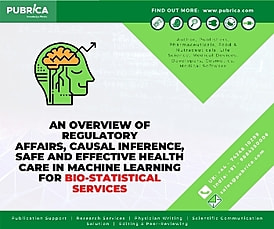
An overview of meta-analysis inthe field of cardiovascular imaging using artificial intelligence
September 30, 2020
An overview of Regulatory affairs, causal inference, safe and effective health care in machine learningfor Bio-statistical services
October 6, 2020Brief:
- The bio medicos conducting researches using humans as their subjects is one of the greatest challenges in clinical medicine research.
- The research report should have basic principles that give the ethical foundation for the performance of research using human participants
- Scientific writing helps to understand the regulations to be followed using a human research subject was discussed in Pubrica, clinical research services.
Introduction:
The human subject’s protection used for research purposes was outlined by Nuremberg in Germany under the Nazi government. He outlines that humans undergoing research experiments should be treated with ethical principles considering their safety purposes. However, many countries accepted and followed his code of ethics in human subject protection. The National Commission for the Protection of Human Subjects of Biomedical and Behavioral Research found and circulated recommendations that were titled the Belmont Report. Scientific medical writing companies should have a clear idea about it while writing medical writing for clinical trials.
Basic principles for human research subjects
- Biomedical researchers involving humans as their subjects must check the generally approve principles of research and should be based on sufficiently performed laboratory protocols with animal experimentations.
- Experiments involving humans should be formulated with a protocol. The protocol is then forwarded to a committee and verified.
- The biomedical researchers involving humans should be performed by scientifically qualified persons and under the supervision of a clinically competent medical person
- The responsibility for the human subject goes with a medically qualified person and never depends on the subject of the research.
- Biomedical research involving human subjects cannot legally be carried out until or unless the objective of the research should look after the risk to the subject.
- The risk factor is more important than the foreseeable benefits in research involving humans.
- Privacy of the subjects is as important as the objective of the research. Their physical and mental integrity should not be studied.
- Doctors should desist from engaging in research projects involving human subjects until they are happy that the toxic injected are believed to be measurable. Doctors should abstain the investigation if the hazards are found to be higher than the potential benefits.
- During publication, the doctors should preserve with accurate results. The results should be following the principles.
- In every project, the subject should be informed with the aim, objectives and procedures of the research and they must declare it with a document signed.
- The subject’s family must also accept the rules and regulations.
- The legal procedures are mandatory. The subject and the doctors must complete all the formalities and in case of any legal incompetence, there will be difficulties in continuing the research.
- The research protocol should always have a statement of ethical considerations of subject to it.
IRB investigations
Any biomedical researchers using humans as their subjects should get an approval from the IRB. The purpose of IRB is to check all the safeguards for humans as per the federal regulations. IRB consists of five professionally qualified and well-experienced persons. The IRB has a right to modify the experiments in case if they find it hazardous to humans. If the biomedical investigator is a member of IRB, The respected person should not participte in the approval of the project. Members of IRB should be unbiased of race, gender, religion.
IRB members should focus on the following contents
- Risk-benefit analysis
- Selection of subjects must be appropriate
- Risk estimation
- Risk evaluation
- The main objective of the research
- Failure modes
- Future studies
FWA( Federal Wide Assurance) assurance
The investigators get funding from the federal agencies, was supported by a common rule federal agency, the investigator must sign an FWA.
The Key features of FWA are,
- Identifying the information about the investigations and filing it.
- Listing the legal components of the institutions that operate under various names
- Stating the ethical principles for the protection of human research subjects
- Indicating that the FWA can take actions on violating the regulations for research purposes
- Demanding an assurance from the insurance
- Getting a written agreement between the organization and FWA
Conclusion
Human protection is the most important challenge during research work. There are many regulations drafted by different countries for human safeguard. Biomedical investigators and research scientists should follow those regulations and work accordingly. The medical research companies should focus on it with the help of Pubrica
References
- World Medical Association. (2001). World Medical Association Declaration of Helsinki. Ethical principles for medical research involving human subjects. Bulletin of the World Health Organization, 79(4), 373.
- Emanuel, E. J., Wood, A., Fleischman, A., Bowen, A., Getz, K. A., Grady, C.,& Muse, C. T. (2004). Oversight of human participant’s research: identifying problems to evaluate reform proposals.
- Gray, B. H., Cooke, R. A., & Tannenbaum, A. S. (1978). Research involving human subjects. Science, 201(4361), 1094-1101.
- King, K. M. (1998). A proposal for the effective international regulation of biomedical research involving human subjects. Stan. J. Int’l L., 34, 163.
- Pritchard, I. A. (2001). Searching for” Research Involving Human Subjects”: What Is Examined? What Is Exempt? What Is Exasperating?. IRB: Ethics & Human Research, 23(3), 5-13.



